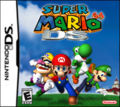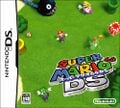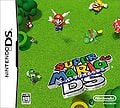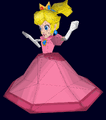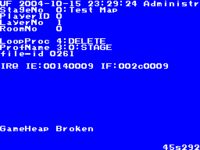List of Super Mario 64 DS pre-release and unused content
This is a list of pre-release and unused content for the game Super Mario 64 DS.
Early iteration[edit]
The game's working title was Super Mario 64x4. Screenshots of this build show elements such as an unused background, all four characters fighting Bowser at the same time (implying cooperative multiplayer), and all four characters flying. The camera in this early version could be positioned anywhere on the map, allowing players to preview an area before they got there.[1]
A demo of the build was playable at E3 2004. One notable difference from the final game is that the courses were not accessible through the hub world (Mushroom Castle and the castle grounds). Instead, the player would have to choose a course from an additional menu on the touch screen (which never made it into the final game), which would show the painting of that course (e.g Jolly Roger Bay appeared as a sunken ship).[citation needed] The multiplayer menu appeared when the Nintendo DS was turned on; this screen also showed the four playable characters.[citation needed] Additionally, the frame rate of the demo was higher than the final version at 60 frames per second.[citation needed] Previews of this build also mention that in single player, the player could switch between all 4 characters using the touch screen,[2][3] in contrast to the more limited transformation system of the final game.
At E3 2004, there was also a demo called Mario's Face where the user could use the stylus to manipulate Mario or Wario's face, and make it 3D or outlined like a cartoon. This could have been an early version of Mario's Face in Super Mario 64 DS.
Also, early screenshots depicted Wario with his original long shirt sleeves before adopting the current shorter ones for the final product.
An image of an older version of the Bob-omb Battlefield shows lower-quality versions of textures from the original Super Mario 64, instead of the redone textures in the final game; of note, the rocks appear green on the map, using a texture from the final Bowser battle, as in the original.
Gallery[edit]
E3 2004[edit]
The castle with Goombas surrounding it. An early design of the yellow coin dropped by one of the Goombas can be seen.
The character icons on the touch screen look different from the final game's, looking instead like the faces from the Wanted! minigame.
All four playable characters fighting Bowser. The timer is on the touch screen, the health meter has a simpler design, and the health meter and red coin counter are showing even when the player's health is full and they have no Red Coins.
The four heroes fighting the Chain-Chomp in Bob-omb Battlefield. The textures are different, such as the brighter grass, and dark-green rocks seen on the map that look the same as the original's.
A playable demo of Super Mario 64x4 seen at E3 2004.
An early appearance of a Red Coin in Bob-omb Battlefield seen at the E3 2004 demo of Super Mario 64x4[3]
Pre-release[edit]
A pre-release version of Mushroom Castle. The area map has a higher contrast of color than the final.
A pre-release version of Whomp's Fortress. Wario's touch screen icons are different than the final.
A pre-release version of Jolly Roger Bay. Yoshi's touch screen icons are different than the final.
A pre-release version of Bowser in the Dark World. Mario's touch screen icons are different than the final.
A pre-release version of Shifting Sand Land.
A pre-release version of Slots Shot. The barriers are different as they have a 2D appearance rather being more 3D in the final.
A pre-release version of Pair-a-Gone. The pictures on the cards are different than the final.
Box art[edit]
Early North American box art for Super Mario 64 DS
Unused data[edit]
In the original game, Shifting Sand Land's pyramid had two "homing" Amps. This game replaces them with regular, circling Amps, and homing Amps are nowhere else to be found in this game.
Fully functional red Koopa Troopas can be found in the game's code.[4] Unlike green Koopa Troopas, when red Koopa Troopas see the heroes they will run into them and knock them around (similar to what Bullies do). When they get knocked out of their shells, they do not panic and only walk back to their shells slowly. When the player hits a red shell it slides along the ground, killing foes in its path until the shell hits a wall and breaks. If the shell hits a player, it will take off one piece off the Power Meter. When Yoshi eats a red Koopa Troopa, he can spew fire like in Super Mario World.
Presumably for the sake of completeness, Chief Chilly has messages for Yoshi:
- Encounter: "Hmm? I see you have no mustache. Poor, bald, little creature. It's not a fair fight for you, but luckily, I'm not a fair fighter. Let's go!"
- Defeat: "I simply cannot believe that I lost to a hairless pip-squeak like you! My mustache was my only joy. Now what am I going to do?"
However, it is impossible to reach Chief Chilly as Yoshi unless one uses cheat codes or a glitch to get through the mirror. King Boo also has messages for Yoshi in the Japanese version of the game, but not in other versions.
There is unused text that is presumably intended for transforming into Luigi and Wario for the first time via their caps:
- Luigi: "While searching for Power Stars, you found a magical green cap. When you wear it, you suddenly look and act just like Luigi. You can spin in the air after performing a backward somersault and you can also run on the water for a few moments."
- Wario: "While searching for Power Stars, you found a strange yellow cap. When you wear it, you suddenly look and act just like Wario! Unfortunately, you also smell just like him. Plus, your stubby legs make you a slow walker. But, you are also very powerful. You can break hard objects just by punching them! Now, go retrieve more Power Stars!"
In the final game, only the Mario Cap has text.
Boxes labeled M, L, and W can be found in a test level in the game, which provide the player with caps.[5][6]
Super Mario 64 DS only has one ? Switch instead of three separate ! Switches to activate Cap Blocks. However, in the game's data, there are unused message slots indicating the original switches were meant to be in the game at some point, and the switch used in game (hatena_switch) has an unused duplicate named hatena_red_switch, implying switches of other colors may have planned earlier in development.[7] The yellow ! Block is incidentally labeled as "ITEM_BLOCK" internally, which is the Japanese name of Cap Blocks from Super Mario 64, despite its model being located within obj_hatena_box/obj_hatena_y_box, which may indicate that it was also intended to be changed to a type of ? Block. This could also have roots from the Super Mario 64 source assets, wherein the yellow block was coded as one of four "ItemBox" types.
In the game files, there are six unused Peach animations, which are for running, being idle, and jumping.
Unused room[edit]
The original version of the Princess's room is still in the castle's model, and aside from a lack of collision data and corrupt textures, it is a near exact replica. The warp to The Princess's Secret Slide is still intact as well. This can be viewed briefly in-game when its ★ door is opened, but the game warps the player to the new version.
Debug screen[edit]
A debug screen exists within Super Mario 64 DS and New Super Mario Bros. It is also similar to the debug screen in Paper Mario for when the game attempts to manage an invalid function (e.g. from the Herringway glitch).
This screen can only be accessed through hacking, or when the player enters the combination of buttons - ![]() +
+![]() +
++
![]() , let go,
, let go, +
![]() , let go,
, let go, +
after the game freezes. This screen cannot be accessed if the player simply removes the game cartridge. Doing so will freeze the entire game, whilst if the player freezes the game through the use of for example, excess use of the multiple hat glitch, the game will display a blue screen which documents current in-game processes such as the player's location.
The player can also put their DS into Sleep Mode and quickly remove and reinsert the cartridge, so that when the player takes the game out of Sleep Mode the game will still be running but will crash when attempting to load new information from another byte (e.g. when the player attempts to use a door to access another location) because such data is not cached, yet the debug screen is cached as soon as the game is booted up. [8]
Unlike the older debug menu in the original Super Mario 64, however, the player cannot alter any in-game processes this way.
References[edit]
- ^ (May 13, 2004). E3 2004: Super Mario 64x4: DS Hands-On. Kikizo. Retrieved September 26, 2020.
- ^ Gerstmann, Jeff (May 14, 2004). Super Mario 64x4 E3 2004 Hands-On. GameSpot. Retrieved August 22, 2012.
- ^ a b IGN (June 23, 2011). Super Mario 64 DS Nintendo DS Gameplay_2004_05_13. YouTube. Retrieved September 26, 2020.
- ^ mariomadproductions (December 14, 2013). SM64DS: Unused parameter of Koopa Troopa. YouTube. Retrieved January 21, 2014.
- ^ TCRF. Super Mario 64 DS. The Cutting Room Floor. Retrieved March 30, 2014.
- ^ Matthew Waters (August 28, 2006). Super Mario 64 DS Action Replay Fun! YouTube. Retrieved April 7, 2010.
- ^ SKELUX (May 13, 2018). What Happened to THESE in Super Mario 64 DS? YouTube. Retrieved May 15, 2018.
- ^ Torchickens (August 17, 2009). The DS's equivalent of 'Crooked Cartridge'. Glitch City Laboratories Forums. Retrieved April 7, 2010.









![An early appearance of a Red Coin in Bob-omb Battlefield seen at the E3 2004 demo of Super Mario 64x4[3]](https://mario.wiki.gallery/images/thumb/0/04/Beta_Red_Coin_-_Super_Mario_64x4.png/120px-Beta_Red_Coin_-_Super_Mario_64x4.png)











